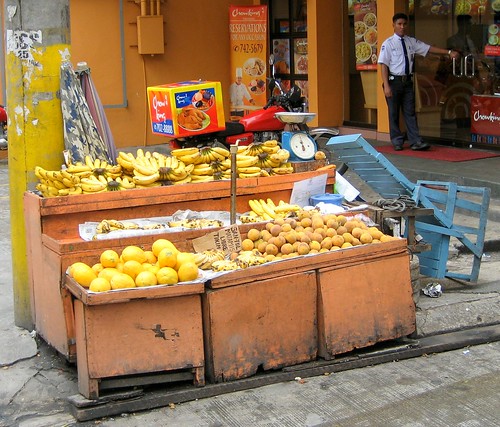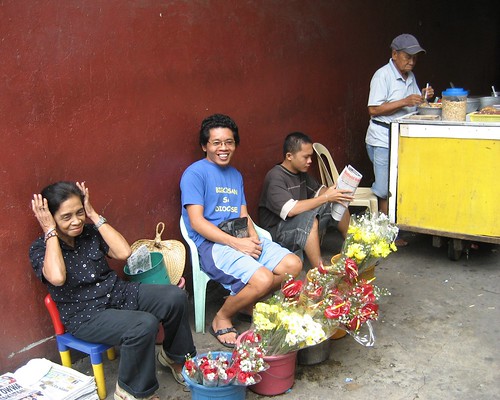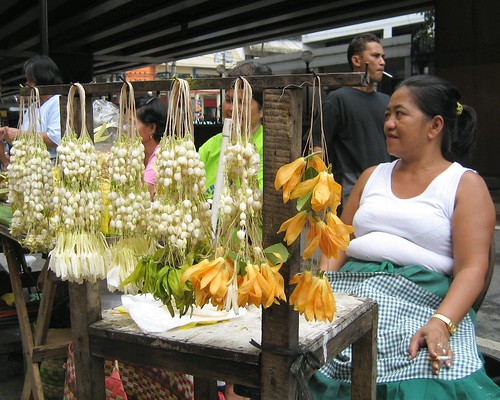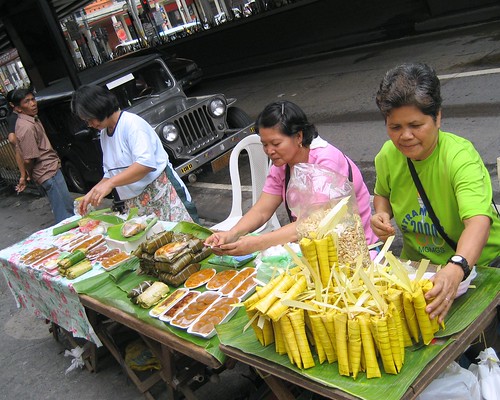Wednesday, July 16, 2008
COTTON CANDY VENDOR IN QUIAPO

Imagine my great surprise when I ran into this cotton candy vendor at the corner of Bilibid Viejo and Matapang Streets in Quiapo the other day. It has been ages since I've had one of these sweet treats.
According to CottonCandy.net, although it's made mostly of sugar and food coloring, cotton candy doesn't contain all that much sugar; only as much sugar as one would get from drinking a can of soft drink. Supposedly, a normal serving of cotton candy (about a 1 oz. cone) contains only about 100 calories; that is, compared to anywhere from 130-170 calories in a can of non-diet soft drink.
Nonetheless, watching how cotton candy is made never cease to fascinate me -- sugar, along with some food coloring, is poured into the bowl at the center of the machine. The heated rim melts the sugar and out through the center bowl's tiny holes it gets spun out of. It then solidifies in the air looking like cotton within the large cylindrical metal bowl.
And from this vendor, the small one costs five pesos, while the large is ten.



I very much appreciate my articles and photos appearing on fellow bloggers' sites, popular broadsheets, and local broadcast news segments, but I would appreciate even more a request for permission first.
Thank you!
*
Labels: Featured food, Street foods
posted by Señor Enrique at 7:04 AM
| 24 comments
![]()
![]()

Thursday, July 03, 2008
THE BEST TURON SABA VENDOR IN QUIAPO

It remains as one of my favorite merienda foods. I can eat one everyday, in fact. The caramelized deep-fried crispy wrapper and the soft saba banana with a sliver of langka (jackfruit) inside make a heavenly texture.
The ones we make at home are much smaller and only slightly sweetened with brown sugar (above photo) unlike those sold by street vendors. However, the best turon and banana-cue street vendor in Manila that I know of is in Quiapo -- right on Bilibid Viejo and Ludovico Streets (near Loyola Street, formerly Lepanto). She has become so popular that the administration office staff from a couple of major universities in the area order turon by the hundreds from her during special school affairs. Hence, none would be available for the public on those days.
I was also told that the vendor, for sanitary reasons, first boils the sticks that she use for her banana-cues. Moreover, word has it that her earnings from selling turon and banana-cue enables her to send her kids to school. The eldest has already graduated from college and now working abroad.
The photos below were taken from her stall. Both the turon and banana-cue are ten pesos each.



I very much appreciate my articles and photos appearing on fellow bloggers' sites, popular broadsheets, and local broadcast news segments, but I would appreciate even more a request for permission first.
Thank you!
*
Labels: Featured food, life in Manila, Quiapo, Street foods
posted by Señor Enrique at 7:13 AM
| 16 comments
![]()
![]()

Tuesday, April 10, 2007
MANILA STREET FOODS

When I was a kid, the woman who sold banana-cue and kamote-cue in the middle of our block would also be selling halo-halo at this time since it’s now summer. During the afternoons, besides this woman, there was also Mang Fermin who sold dirty ice cream or sorbetes, as well as the weekend kakanin vendors comprised mostly of neighborhood kids. There was also the kernel corn or binatog vendor.
The freshly-baked pandesal and machakaw were available from our neighborhood baker, Perfection Bakery, in the early morning and again at around three o’clock in the afternoon. The taho, puto, kutchinta, and bicho were peddled only in the morning by Chinese vendors, while at night was the usual Pinoy balut and chicharon vendor.
Right in front of Cine Noli on Avenida Rizal near Blumentritt, was the street vendor who roasted corn on the cub right there on the sidewalk and the vendor who sold fried peanuts with garlic. It was the former that my Tiyang Inez would bribe me with so I would accompany her to see the latest Lepoldo Salcedo or Rosa Mia tear-jerker flick inside that surot-infested movie house.
Over in Sta. Cruz — more popularly known as “downtown” back then — the only food I remember being sold right on the sidewalk was hopia, but it was always in front of a Chinese bake shop. It was the same scene along the entire stretch of Azcarraga (now known as Claro M. Recto Avenue) by the university belt area. Neither was there a single street food vendor in the vicinity of my high school — whether in Doroteo Jose or Intramuros. For the most part all foodstuffs were only available inside the student canteens or in the restaurants; two of the most popular among the students and the general public back then was Little Quiapo and Ma Mon Luk.
Today is a different story.
Sidney Snoeck has done an exhaustive pictorial series of street foods; whereas, Ivan Henares has come up with a comprehensive listing of which, including those unheard of during the days of my youth. For example, certain ingredients of pancit canton guisado, much to my astonishment, are now merchandized as individual merienda offerings — fish balls, kikiam, and what appear to be boiled eggs breaded with yellow flour. There is also the popular chicken feet and day-old chicks, as well as barbecued pig and chicken innards or lamang loob.
Incidentally, pork barbecue are now commonly found at any densely-populated neighborhoods from the early afternoon until the late evenings. Even lugaw and noodles are sold on roving makeshift bicycle carts.
I don't usually buy any of this new generation of street foods, not because I'm overly concerned about sanitary issues; rather, I find most of these foods extremely salty. I guess having lived in New York for so long made me develop a bland taste; ground pepper is the only condiment I use, salt I can often do without. I've also steered away from lumpia and turon (banana with a strip of jackfruit or langka) from street vendors because the oil they use for frying rarely agrees with my system. The smell alone of the hot oil used to deep-fry fish balls and kikiam would sometimes make me dizzy.
Nonetheless, when I was a kid, I used to look forward to going with my father to the palengke on an early Saturday morning, because almost always, we’d eat palabok for breakfast at one of the market’s food stalls. It was delicious. Whereas, in the afternoons, my mother would give us some change for some banana-cue, kamote-cue or turon.
As for the puto and kutchinta, at present, I only buy the latter from Dolor's Kakanin, while the only kind of puto that I really enjoy these days are those mini puto from Dagupan City that my sister would have delivered to her office. Gone are those really tasty puto, kutchinta and bicho; the ones available now are not as good. Gone, too, are those Chinese vendors who used to peddle them in my old neighborhood.
And be that as it may, believe it or not, I still enjoy an occasional balut.

.
Labels: Street foods
posted by Señor Enrique at 6:46 AM
| 40 comments
![]()
![]()

Tuesday, August 01, 2006
SOME MANILA STREET VENDORS

As wise men say, change is good, especially when buying from street vendors. Check out this fruit stand left unattended by a vendor who was desperately looking to get some change from other merchants in the vicinity (top photo).
Anyway, I took some pictures of street vendors as my initial attempt in street photography. Sidney was right! All one has to do is ask for people's permission first before shooting away like mad. I was happy that those I asked gladly consented; without so much as obliging me to buy anything beforehand.
Please click on the following images to enlarge for a better view:
 Viral marketing: An entire family of street vendors. There’s grandma, mama, sonny, and grandpa. Papa was still home sleeping; dead tired from last night’s drinking binge.
Viral marketing: An entire family of street vendors. There’s grandma, mama, sonny, and grandpa. Papa was still home sleeping; dead tired from last night’s drinking binge.
 The sampaguita garland vendor: She once aspired to conquer Tokyo by entertaining a flock of Japanese power brokers, but her extremely possessive husband refused to let her go. Even now when she’s working, he’d sneakily check up on her. But that’s not him at the background, though; he’s the one on the photo below near the rice cake ladies.
The sampaguita garland vendor: She once aspired to conquer Tokyo by entertaining a flock of Japanese power brokers, but her extremely possessive husband refused to let her go. Even now when she’s working, he’d sneakily check up on her. But that’s not him at the background, though; he’s the one on the photo below near the rice cake ladies.
 The rice cake, suman and kakanin vendors: According to these three women, they stopped bickering and joined forces upon realizing that underselling each other only hurt their profit margin. Nowadays, with collective price-fixing, they’re as happy as can be. Come to think of it, don’t they look like they’re about to break into a song?
The rice cake, suman and kakanin vendors: According to these three women, they stopped bickering and joined forces upon realizing that underselling each other only hurt their profit margin. Nowadays, with collective price-fixing, they’re as happy as can be. Come to think of it, don’t they look like they’re about to break into a song?
 The Indian Mango vendor: Even in street peddling, “it helps when you got the good looks,” so claims this Senor Romantico. Check out the woman in blue in such scandalous position; unable to wait a second longer to cop a feel of his mango.
The Indian Mango vendor: Even in street peddling, “it helps when you got the good looks,” so claims this Senor Romantico. Check out the woman in blue in such scandalous position; unable to wait a second longer to cop a feel of his mango.
The Davao grapefruit and Indian mango vendor: I asked her why she looked so gloomy. “Is it because of the impending rain?” I asked while trying to catch her eyes. “No,” she said as she half-peeled a grapefruit.
“Is it the hardship involved in your line of work such as fending off some street thugs hustling for protection money, or dodging the traffic cops out to weasel a couple of bucks off you for their merienda?” This time she motioned with her head to indicate another no yet, her chest heaved a deep sigh of longing.
“Is it because of our universe that's constantly expanding?” I persisted. “No! I’m just out of load…I cannot text my boyfriend in Dumaguete,” she exclaimed.
Labels: life in Manila, Street foods, Street vendors
posted by Señor Enrique at 6:38 AM
| 19 comments
![]()
![]()




